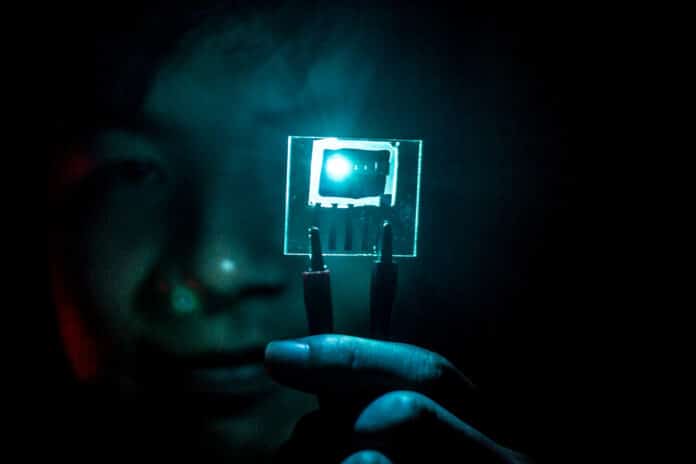Soon, lights might use super-efficient organic light-emitting diodes (OLEDs) that last a really long time, all thanks to a new discovery by scientists at the University of Michigan.
These new OLEDs, called phosphorescent OLEDs or PHOLEDs, can keep 90% of their blue light brightness for 10-14 times longer than other similar designs. This improvement makes blue PHOLEDs durable enough for commercial use in lights that meet the Department of Energy’s 50,000-hour lifetime goal. Without a stable blue PHOLED, less efficient technology is needed to create white light in OLED lights.
Phosphorescent organic light-emitting diodes (PHOLEDs) are great for displays and lighting because they’re efficient, bright, and can be adjusted for different colors. However, making blue PHOLEDs last longer is a tough challenge in organic electronics. The short lifespan of blue PHOLEDs is because high-energy blue triplets break down molecules.
The Purcell effect, which boosts the radiative decay rate in a microcavity, can help by reducing the density of triplets, lowering the chances of destructive events that harm the blue PHOLEDs.
In a new study, scientists introduced the polariton-enhanced Purcell effect in blue PHOLEDs. They found that the plasmon-exciton-polaritons (PEPs) significantly increase the strength of the Purcell effect.
Stephen Forrest, the Peter A. Franken Distinguished University Professor of Electrical and Computer Engineering at the University of Michigan, said, “Achieving long-lived blue PHOLEDs has been a focus of the display and lighting industries for over 20 years. It is probably the most important and urgent challenge facing the field of organic electronics.”
PHOLEDs are highly efficient, with almost 100% internal quantum efficiency. This means that all the electricity they use is turned into light. As a result, lights and displays using PHOLEDs can produce brighter colors for longer durations using less power and creating fewer carbon emissions.
To create blue light, electricity makes particular molecules excited. Sometimes, these excited molecules bump into each other before making the light, combining all their stored energy into one molecule. Since blue light has a lot of energy, this doubled-up energy can break chemical bonds and damage the material.
To solve this, scientists often use materials that emit a wider range of colors, which lowers the total energy. But these materials look more cyan or green than a deep blue.
The U-M team found a way around this by placing cyan material between two mirrors. They adjusted the space between the mirrors right so only the most profound blue light waves could stay and eventually come out of the mirror space.
The researchers improved the properties of the light-emitting layer by adjusting it next to a metal electrode. This introduced a new quantum state called a plasmon-exciton-polariton, or PEP. This new state enables the organic material to emit light quickly, reducing the chances of excited states colliding and damaging the light-emitting material.
Study co-author Claire Arneson, a doctoral student in physics and electrical and computer engineering, said, “In our device, the PEP is introduced because the excited states in the electron transporting material are synchronized with the light waves and the electron vibrations in the metal cathode.”
Journal Reference:
- Zhao, H., Arneson, C.E., Fan, D. et al. Stable blue phosphorescent organic LEDs that use polariton-enhanced Purcell effects. Nature (2023). DOI: 10.1038/s41586-023-06976-8
